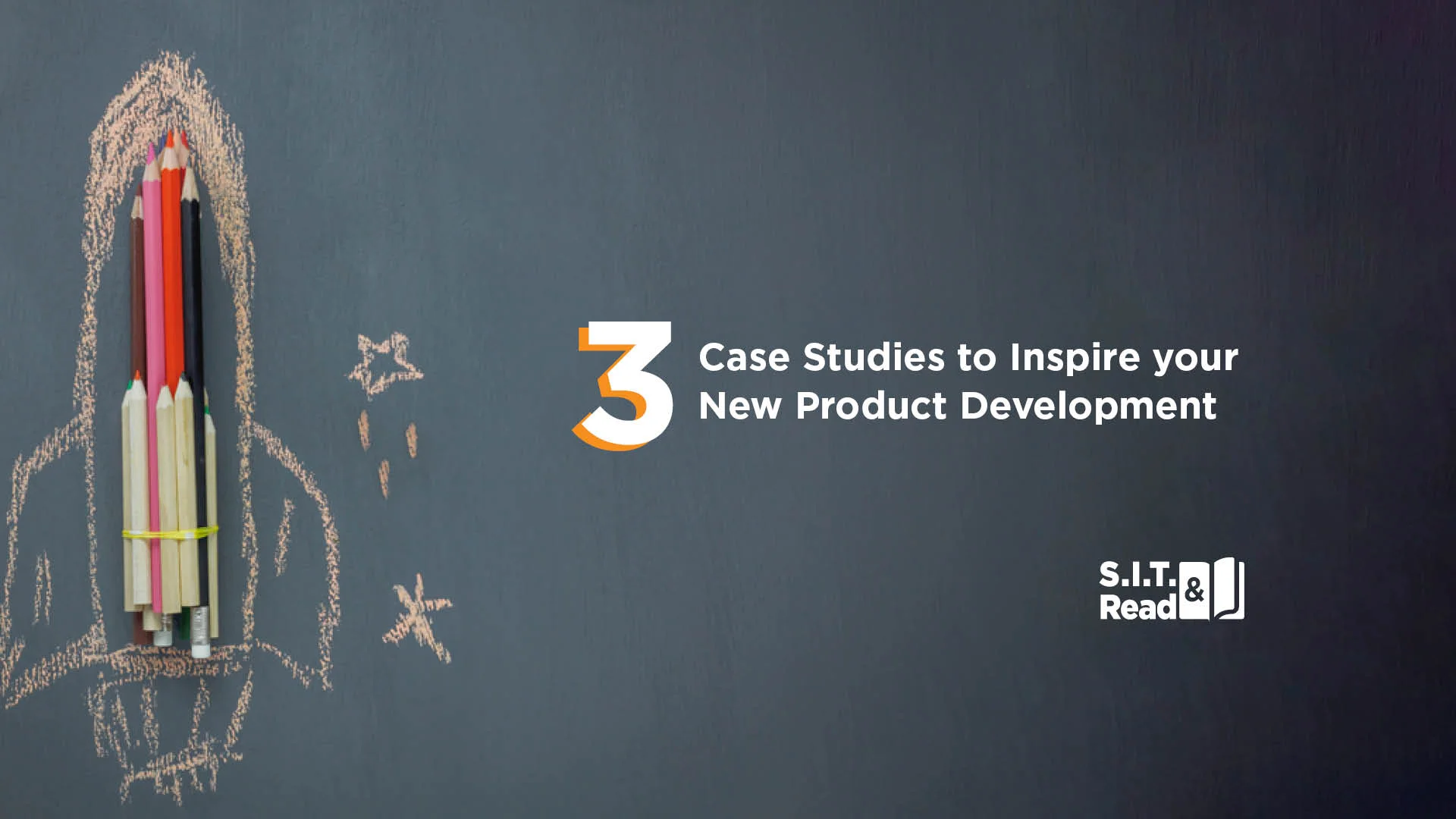3 SIT Case Studies to Inspire Your Company’s New Product Development


Companies are constantly trying to create something fresh and original, but where do they even start? A common go-to is good ole brainstorming, but as we have repeatedly stressed, this is not an effective way to ideate. That’s when SIT steps in – making ideation more efficient and creative through proven, structured strategies and methods. SIT’s project outcomes are commonly true revolutions in the sector, even though they are based on your existing products or services. Here are some NPD case studies that we are proud to have led, which exemplify SIT’s methodology in practice.
Not Just a Summer Drink
On a scorching summer day, nothing is more refreshing than a nice, cold bottle of iced tea. But what about the wintertime? How can a Business Unit that sells such summer staples like Nestea® also boost sales during the colder months and gain an edge on competing companies such as Lipton, the leader in the industry?
Nestea’s traditional approach of identifying market trends to develop new products was not generating enough revenue. Moreover, non-compete restrictions from a joint venture of their parent company, Coca-Cola/Nestle, put further pressure on Nestea® to steer clear of soft drinks and hot beverages. Thus, the Nestea® brand team needed to develop a new product that was unique in their own domain. They called in SIT to help innovate under these constraints.
During the process, we applied our attribute dependency tool, which creates and dissolves dependencies between variables of a product, SIT was able to help Nestea reevaluate the relationship between changing seasons and beverages offered. Nestea’s® team challenged the expectation that iced tea is only for the summer and launched a line of iced tea for the winter. Applying their existing strength in flavor innovation to ensure the development of a unique and unexpected product, they landed on a concept that would accompany consumers’ winter drinking habits: a bottled tea that would be even more appealing when consumed at room temperature or when heated (as opposed to being cooled). Here, the industry’s fixedness, i.e. bottled tea is served cold (and is called “iced tea!”) was shattered and replaced with a dynamic, interesting alternative that created a whole new “ready-to-drink tea” product line. The pilot product, Snowy Orange, sold-out within the first week of launch in Germany. The following winter, the product was introduced into additional markets and this expanded “limited edition” sold out before the end of January.
It is now an annual staple in their product range throughout Europe, accounting for 10% growth in annual sales.
Achieve Naturally Soft & Radiant Skin
As any beauty consumer will tell you, diligent skincare is the key to radiant confidence and glowing skin. AHAVA Laboratories is a world leader in mineral-based cosmetics: their unique formulas, made of elements found only in the Dead Sea, are the foundation of millions of skincare routines. In a two-year partnership with SIT, AHAVA sought to further their enterprise by developing new products. Even though AHAVA had the power of the Dead Sea on their side, in a market saturated with hundreds of different creams and washes—all claiming one secret ingredient or another—AHAVA needed to create products with a different “wow” factor.
One product concept came from our task unification tool —a way to assign an additional task to an existing resource. Together, we discovered a way to use the body’s own moisture to dissolve active ingredients in the product upon application to the skin. Usually, this process is achieved by adding water during the manufacturing process. However, using SIT’s creative process led to the invention of the Gentle Body Exfoliator, which requires only the body’s natural moisture. Because the Gentle Body Exfoliator is untreated, it has the additional benefit of a rough texture when applied, which removes dead skin cells. As the product interacts with the body’s own moisture, it dissolves into the skin, nourishing it with Dead Sea minerals. Naturally soft, smooth, and radiant skin has never been achieved like this before.
Which Scents Define Your Home?
We’re all familiar with the Febreze brand, providing a “Breath of Fresh Air” in our homes. But until the work with SIT, Febreze existed only in P&G’s Fabric Care category, removing odors from couches, armchairs, and carpets. Air Care was dominated by strong competitors: Glade (SC Johnson) with a whopping 55% market share, Wizard (Reckitt-Benckiser), and Renuzit (Dial). However, with category profit margins high, and clear right-of-entry into this adjacency, Procter & Gamble had to find a way in. They knew that only a truly different product would stand a chance of stealing any significant market share.
SIT was called in to help leverage P&G’s unparalleled expertise in scent-development (perfumery), while borrowing from Febreze’s brand equity, to identify a concept for a game-changer in the Air Care space. Applying our Multiplication tool, which adds an additional component of a product and then alters it in some way, we imagined a wall plug-in with 2 vials: one with Febreze technology + scent A; the other with Febreze technology + scent B. A novel idea emerged; if there were two separate tanks to hold the perfume, the device could alternate pulsing between scents. This would answer a consumer need that everyone had been aware of, but no competitor could figure out a solution for. The technical term is “habituation”, but we all know it as the experience when you enter a room with a distinct scent (or, more commonly, odor) and several minutes later you no longer notice it until you leave and reenter. The market had been unhappy (but forgiving) of the fact that they were wasting their money on a room freshener that evaporated perfume all the time, but they only benefited from for a couple of minutes each time they entered the room. P&G had solved this through the multiplication concept – every few minutes, the scent changed from one vial to the next – alternating between two pleasant scents and avoiding the customer’s sensory habituation. In classic P&G marketing genius, they sub-branded this disruptive innovation Febreze “NOTICEables” and in less than 4 years after launch, had garnished more than 25% market share. NOTICEables has become the standard for plug-ins, so P&G rebranded it in 2020 as simply Febreze Plugs.
Turning Constraints into Advantages
Through the stories of Nestea, AHAVA, and Febreze, we see three examples of successful innovation that not only changed the game but disrupted their sectors. Instead of brainstorming or following market trends, the SIT methodology converted the companies’ constraints into advantages, innovating new solutions, and unlocking latent consumer needs in the process.
Recent Posts
Innovation Behavior
Innovation is a skill, not a gift. Top organizations drive growth by nurturing and investing…
Should you learn TRIZ? – Yes. ….and No.
Are you in the world of problem solving? Is problem solving a skillset you have…
What Lies Ahead in 2024?
5 Data-Driven, Customer-Centric trends we’ve identified This is not just another conventional forecast. Over nearly…
Fork or Chopsticks – Which Innovation Tools Do You Use?
Imagine a chef, who only uses a spoon. Imagine a dentist, who only uses a…
The Moat Mentality: Exploring New Frontiers in Innovation Methodologies
In investing and business strategy, we often speak in terms of moats. Warren Edward Buffett…
Was it a Breakthrough or an Adjacency?
This year, P&G’s Febreze celebrates its silver anniversary as a brand. But not all 25…



View Comments
I don't think the title of your article matches the content lol. Just kidding, mainly because I had some doubts after reading the article. https://www.binance.com/fr/join?ref=PORL8W0Z
Can you be more specific about the content of your article? After reading it, I still have some doubts. Hope you can help me.